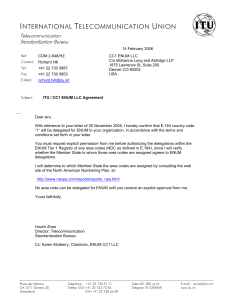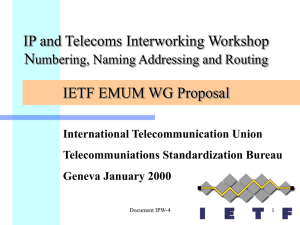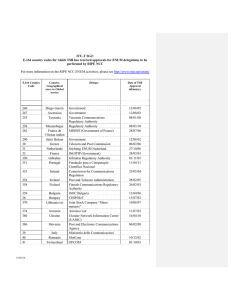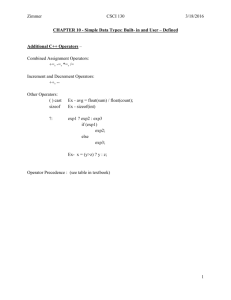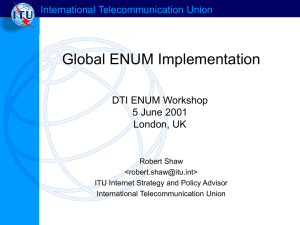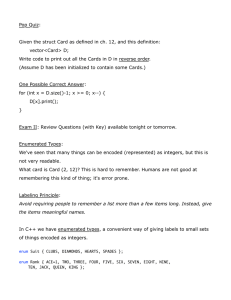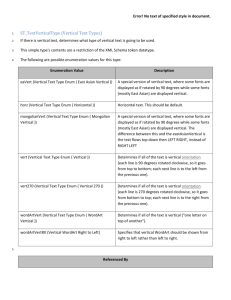Attachment 14 ENUM Table of contents
advertisement
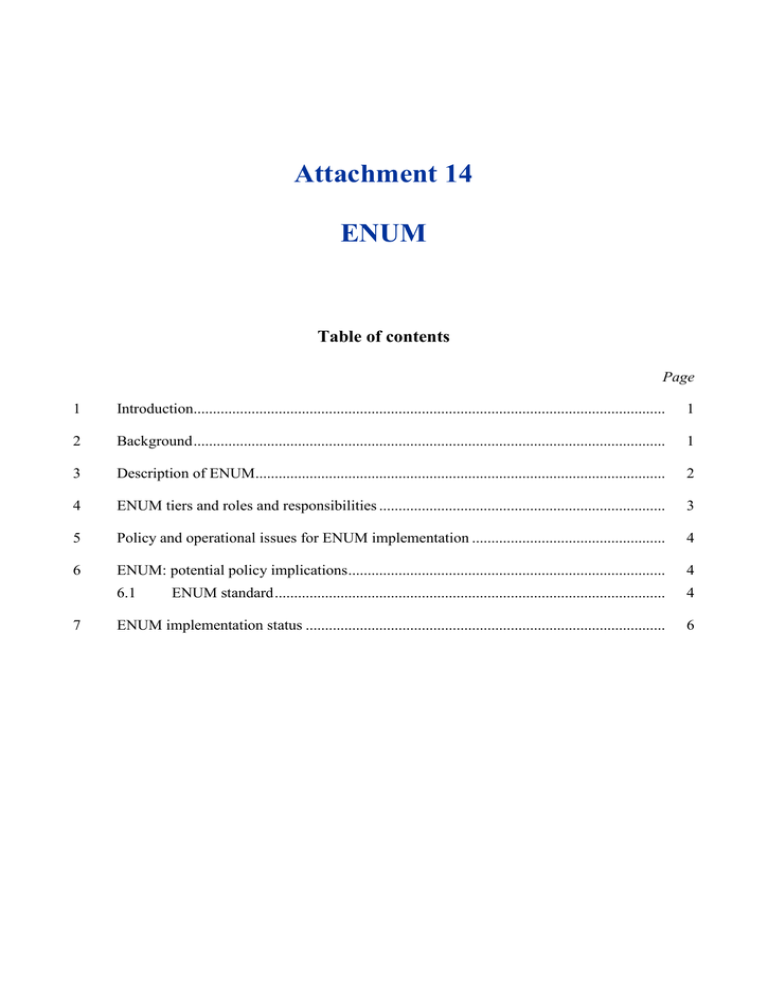
Attachment 14 ENUM Table of contents Page 1 Introduction.......................................................................................................................... 1 2 Background .......................................................................................................................... 1 3 Description of ENUM.......................................................................................................... 2 4 ENUM tiers and roles and responsibilities .......................................................................... 3 5 Policy and operational issues for ENUM implementation .................................................. 4 6 ENUM: potential policy implications .................................................................................. 4 6.1 ENUM standard ..................................................................................................... 4 ENUM implementation status ............................................................................................. 6 7 Internet Protocol (IP) – Attachments ENUM1 1 Introduction The intent of this section is to provide some tutorial material to facilitate discussions of the requirements for the successful global implementation of ENUM, as described in IETF RFC 3761 (formerly RFC 2916). Additional tutorial material can be found in Supplements 3 and 4 to ITU-T Recommendation E.164. The ENUM protocol depends upon mapping parts or all of the ITU-T Recommendation E.164 international public telecommunication numbering plan into the Internet Domain Name System (DNS). At first glance a simple protocol, ENUM nevertheless raises a number of regulatory and policy issues. One of the technical challenges raised by the ever-closer integration between circuit-switched and packet-switched networks is how to address calls that pass from one network service to another. Generally, it is assumed to be desirable that an integrated global subscriber access plan exists. For example, the same ITU-T E.164 telephone number would reach a subscriber regardless of whether IP-based or PSTN network technologies are used. It is now widely possible to originate calls from IP address-based networks to other networks, but it is uncommon to terminate calls from other networks to IP address-based networks. Rather, calls are generally terminated on the PSTN, so the called party can only use a terminal device connected to those networks. In order to access a subscriber on an IP address-based network from the PSTN, some sort of global numbering/addressing scheme across both PSTN and IP address-based networks needs to be developed and implemented. ENUM could provide that numbering/addressing scheme. This section is intended for readers who have a basic understanding of ENUM, the ITU-T E.164 international public telecommunication numbering plan and DNS. Section 4.2 provides a technical overview of how DNS works. 2 Background The ENUM protocol, published in the standards-track document RFC 3761 (formerly RFC 2916), proposes mapping ITU-T Recommendation E.164 telephone numbers into DNS. An overview of how DNS works is given in § 4.2. The ENUM protocol involves associating telephone numbers with network resources or services in DNS. For example, a specific E.164 number can be coupled with, inter alia, other E.164 numbers, such as fax and mobile numbers, voice mail systems, an IP telephony address, an e-mail address, a website or any other resources or services that can be identified through a widely-used Internet addressing scheme called uniform resource identifiers (URIs). ____________________ 1 This section is based on a tutorial paper, ITU/T Study Group 2 Information Document 10. Attachment 14 – ENUM 1 Internet Protocol (IP) – Attachments he ENUM protocol requires that related services be looked up through a convention of one-to-one reverse mapping of digits in an ITU-T Recommendation E.164 number into separate DNS "zones" – which are then concatenated with another domain. The Internet Architecture Board (IAB), has proposed that this domain be "e164.arpa". At this time, there is not yet final consensus by ITU Member States on the usage of the e164.arpa zone or of a particular operator of this domain. With that disclaimer, the domain "e164.arpa", referenced in RFC 3761, is used below solely for the sake of discussion. 3 Description of ENUM ENUM is a protocol which is the result of work by IETF's Telephone Number Mapping working group. The charter of the ENUM working group was to define a DNS-based architecture and protocol for mapping an ITU-T Recommendation E.164 telephone number to what are known as uniform resource identifiers (URIs) . A stable standards-track version of the ENUM protocol has been published as RFC 3761. URIs are strings of characters that identify resources such as documents, images, files, databases, e-mail addresses or other resources or services in a common structured format. The most commonly known types of URIs are uniform resource locators (URLs), which are used to locate resources using the worldwide web. For example, http://www.itu.int/infocom/enum/ is the URL for the ITU website providing an overview of ITU ENUM activities. The ENUM protocol uses what are called naming authority pointer (NAPTR) DNS resource records as defined in RFC 2915 in order to identify the available methods or services for contacting a specific node identified through a Recommendation E.164 number. The ENUM protocol defines and uses a specific type of NAPTR service with the mnemonic "E2U" (E.164 to URI resolution). The result of an ENUM query can be one or more URIs with their order of processing and preference indicated by values in the NAPTR records. These URIs are then used to reference resources or services associated with the Recommendation E.164 number. Possible examples of resources or services include fax number, mobile number, e-mail address, GPS coordinates, phone redirection services, unified messaging services, voice mail and public key for asymmetric encryption applications. How are E.164 numbers mapped into the DNS? The ENUM protocol requires that related services be looked up through a convention of one-to-one reverse mapping of digits in an ITU-T Recommendation E.164 number into separate DNS "zones" – which are then concatenated with another domain. The Internet Architecture Board (IAB), has proposed that this domain be "e164.arpa". As at 1 September 2001, there is not yet consensus by ITU Member States on the usage of the e164.arpa domain or of any particular operator of that domain but with that caveat, it is used below for the sake of discussion. As an example, let us construct the related DNS domain to look up NAPTR resource records associated with the number +33 1 40 20 51 51, which corresponds to the information desk at the Louvre Museum in Paris, France: Write the E.164 number in its full form, including the country code, then remove all nondigit characters with the exception of the leading "+". Example: +33140205151 Remove all characters with the exception of the digits and put dots (".") between each digit. 2 Attachment 14 – ENUM Internet Protocol (IP) – Attachments Example: 3.3.1.4.0.2.0.5.1.5.1 Reverse the order of the digits and append the ENUM Tier-0 zone to the end. Example: 1.5.1.5.0.2.0.4.1.3.3.e164.arpa If the Louvre Museum had chosen to provision its number in the DNS for ENUM services, the client application could now perform a look-up on this name and, for example, retrieve the NAPTR records for a corresponding fax number, e-mail address or any other URI for the E.164 number +33 1 40 20 51 51. 4 ENUM tiers and roles and responsibilities There is a range of options for describing ENUM administrative and technical levels and roles. However, some commonly used working definitions have emerged where Tier-0 refers to the root level of the ITU-T E.164 numbering plan, Tier-1 refers to the next level at the "country code" level, and Tier-2 refers to an actual subscriber telephone number. The ITU Constitution and Convention set forth the functions and role of the ITU Telecommunication Standardization Sector (ITU-T), the world telecommunication standardization assemblies, as well as the Director of the Telecommunication Standardization Bureau (TSB). The role of the TSB Director and ITU Member States with respect to the allocation and management of numbering resources is defined in Resolution 20 – first issued by the World Telecommunication Standardization Conference (Helsinki, 1993) and most recently adopted by ITU Member States at the WTSA in Montreal (2000). Resolution 20 states "that the assignment of international numbering and addressing resources is a responsibility of the Director of the TSB and the relevant administrations", where the term "administration" is a term defined in the ITU Constitution as "Any governmental department or service responsible for discharging the obligations undertaken in the Constitution of the International Telecommunication Union, in the Convention of the International Telecommunication Union and in the Administrative Regulations." In accordance with the above, it is agreed that the role of ITU Member States with respect to the allocation and management of their numbering resources, including the potential provisioning of those resources in the DNS, will be maintained. As ITU-T Study Group 2, Working Party 1/2, has stated, in a liaison statement to IETF/ISOC: "It is noted that most ENUM service and administrative decisions are national issues under the purview of ITU Member States, since most of the E.164 resources are utilized nationally." If parts of the Recommendation E.164 numbering plan are to be authoritatively provisioned in the DNS, it is assumed that there is a requirement for an authoritative DNS infrastructure that parallels, at least to some extent, the hierarchical roles and responsibilities that currently exist for the E.164 numbering plan. In the case of geographic resources, it is recommended that the legal authority for any ENUM Tier-1 domain corresponding to a country code resource be the corresponding ITU Member State or its designated delegates. Only in this case will the administration of the corresponding ITU Member State be able to legally exercise related policy, as well as coordinate the operational and technical management of the corresponding DNS zone. In the case of E.164 network resources, it is recommended that the legal authority for any ENUM Tier-1 domain corresponding to a network resource should be the corresponding network operator or its designated delegates. In order to ensure the sovereign role of each ITU Member States with respect to the allocation and management of their numbering resources, TSB ensures that each Member State has specifically authorized the inclusion of their Recommendation E.164 country code resource in the DNS, through Attachment 14 – ENUM 3 Internet Protocol (IP) – Attachments instructions from their administration. Upon this authorization, the management of E.164 resources in the DNS is considered to be a national matter and therefore administered by the ITU Member State(s) to which the country code is assigned. Furthermore, it is assumed that, based on the principle of sovereignty, in an integrated numbering plan, each country within the plan may individually administer their portion of Recommendation E.164 resources mapped into the DNS. 5 Policy and operational issues for ENUM implementation As noted above, most of the issues related to ENUM implementation are national issues, to be addressed at the national level. The issues include the following: How to authenticate the identity of the subscriber for ENUM services? Who are ENUM registrars and what are they responsible for? How to validate ENUM data for potential subscribers (Add – Modify – Delete) in the NAPTR list of services and preferences? How are data provisioned in the country code name servers? How to obtain end-user agreement if necessary to enter a number in DNS? How to harden the ENUM zone data against data mining, especially for the purposes of spam? Competition models amongst suppliers of ENUM services, and related portability issues. 6 ENUM: potential policy implications2 ITU-T Study Group 2 is currently addressing principles and procedures for the administration of ENUM as well as defining a framework for the possible role of ITU. A key issue is implementing and maintaining the databases necessary for translation of the E.164 numbers into the Domain Name System so as to safeguard the integrity of the E.164 numbering system. National regulatory authorities or policy makers may wish to consider their appropriate level of involvement in these activities at ITU. More information on the ENUM protocol, and the issues related to it, can be found at www.itu.int/osg/spu/infocom/enum/. 6.1 ENUM standard The ENUM standard, described in IETF's RFC 3761, defines a protocol and an architecture based on the Internet DNS, whereby it is possible to obtain a correspondence between E.164 telephone numbers and call service identifiers, with an order of priority (e-mail, website URL, SIP address of an IP telephony server, voice mail, other telephone numbers, …). Using the ENUM protocol, therefore, it is possible to find the various addresses of the target user on the basis of a simple telephone number. The subscriber or registrar may also customize the manner in which the subscriber may be reached, with a single E.164 number. It is easy to add to or modify such additional information without changing the number used for access. The ENUM protocol is thus seen as a technical gateway ensuring correspondence between the Internet and the switched telecommunication network, enabling interworking between the two. The ENUM protocol and the use of DNS mechanisms do not give rise to any technical problems implying the incorrect functioning of services based on this functionality. However, the ability of the centralized and hierarchy-based DNS architecture to support requests generated by services ____________________ 2 The material in this section was provided by BDT. 4 Attachment 14 – ENUM Internet Protocol (IP) – Attachments requiring the transport of information in real time and with high quality will need to be determined at each level of the DNS architecture, according to the load and to the level of availability required by each service. To find the DNS name of an E.164 telephone number, the RFC 3761 standard requires that the following steps be executed: Step Example 1 Write the E.164 number in its complete form with the country code (IDDD) +46-8-9761234 2 Delete all non-numeric characters except for the symbol "+" +4689761234 3 Remove all non-numeric characters 4689761234 4 Insert a stop (".") between each digit of the number 4.6.8.9.7.6.1.2.3.4 5 Reverse the order of the digits of the number 4.3.2.1.6.7.9.8.6.4 6 Add the string ".e164.arpa" to the end of the number obtained in step 5 4.3.2.1.6.7.9.8.6.4.e164.arpa Using the domain name obtained in the last step of the above procedure, the ENUM algorithm is applied in order to obtain the order of priority of the call service identifiers. The following figure shows an example of the ENUM protocol in the case of use of a conventional (analogue) telephone set via the switched network. Figure 1 – Example of ENUM usage in the case of the switched telephone network Attachment 14 – ENUM 5 Internet Protocol (IP) – Attachments 7 ENUM implementation status List of ENUM national delegations3 E.164 Country Code Country Delegee 246 Diego Garcia Government 12/08/02 247 Ascension Government 12/08/02 290 Saint Helena Government 12/08/02 31 Netherlands Ministry 23/05/02 33 France DiGITIP (Government) 28/03/03 353 Ireland Commission for Communications Regulation 25/05/04 358 Finland Finnish Communications Regulatory Authority 26/02/03 36 Hungary CHIP/ISzT 15/07/02 374 Armenia Arminco Ltd 11/07/03 40 Romania MinCom 10/12/02 41 Switzerland OFCOM 01/10/03 420 Czech Republic Ministry of Informatics 24/06/03 421 Slovak Republic Ministry of Transport, Post and Telecommunications 04/06/03 423 Liechtenstein SWITCH 21/10/03 43 Austria Regulator 11/06/02 44 UK DTI/Nominum 16/05/02 46 Sweden NPTA 10/12/02 48 Poland NASK 18/07/02 49 Germany DENIC 16/05/02 55 Brazil Brazilian Internet Registry 19/07/02 65 Singapore IDA (Government) 04/06/03 86 China CNNIC 02/09/02 971 United Arab Emirates Etisalat 13/01/03 Current status of the national ENUM delegations can be found at: http://www.itu.int/ITU-T/inr/enum/. Information on ENUM trials: http://www.centr.org/kim/enum/index.html. ____________________ 3 As at 3 January 2005. 6 Date of TSB Approval dd/mm/yy Attachment 14 – ENUM
